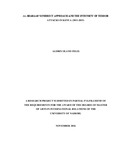| dc.contributor.author | Olayo, Felix, A | |
| dc.date.accessioned | 2017-01-06T05:37:28Z | |
| dc.date.available | 2017-01-06T05:37:28Z | |
| dc.date.issued | 2016 | |
| dc.identifier.uri | http://hdl.handle.net/11295/99345 | |
| dc.description.abstract | The aim of this dissertation is to highlight factors responsible for the intensity of Al-
Shabaab terror attacks in Kenya between the period spanning October 2011 and
December 2015. Between 17th October 2011 and July 17th 2014, Kenya had suffered 133
attacks orchestrated by the Al-Shabaab. By April 2015 these Al-Shabaab attacks had
resulted in more than 600 casualties.
The dissertation had two specific objectives; first to examine factors underpinning Al-
Shabaab’s success in executing terror attacks in Kenya. Second is to examine and analyze
factors underlying the apparent inability of security apparatus to decisively defeat al-
Shabaab. The three attacks selected as a case study are the Westgate mall attack of
September 2013, the Mpeketoni and Lamu attacks of June and July 2014 and the two
attacks in Mandera in November and December 2014.The researcher used in-depth
(expert) interviews, observation and document analysis to collect both primary and
secondary data. Content analysis was then adopted to analyze the data.
This study adopts the theory of Indirect Approach as postulated by Liddell Hart to
explain these attacks. It complements this theory with the concept of Distance Decay
Reduction as proposed by Ngunyi &Katumanga (2014) to further describe, explain and
prescribe solutions to this Al-Shabaab menace in Kenya.
The main thesis of this study are; one, the success of Al-Shabaab group in executing
these attacks is underpinned by their ability to efficiently operationalize the strategy of
indirect approach and adopt it to suit their ends. Two is that the inability of Kenya
security forces to decisively defeat Al-Shabaab owes to their alienation of the population.
The assumption being that the support of the population holds the “intangible centre of
gravity” in these engagements. | en_US |
| dc.language.iso | en | en_US |
| dc.publisher | University of Nairobi | en_US |
| dc.rights | Attribution-NonCommercial-NoDerivs 3.0 United States | * |
| dc.rights.uri | http://creativecommons.org/licenses/by-nc-nd/3.0/us/ | * |
| dc.subject | Al-shabaab’s Indirect Approach and the Intensity of Terror Attacks in Kenya (2011-2015) | en_US |
| dc.title | Al-shabaab’s Indirect Approach and the Intensity of Terror Attacks in Kenya (2011-2015) | en_US |
| dc.type | Thesis | en_US |



